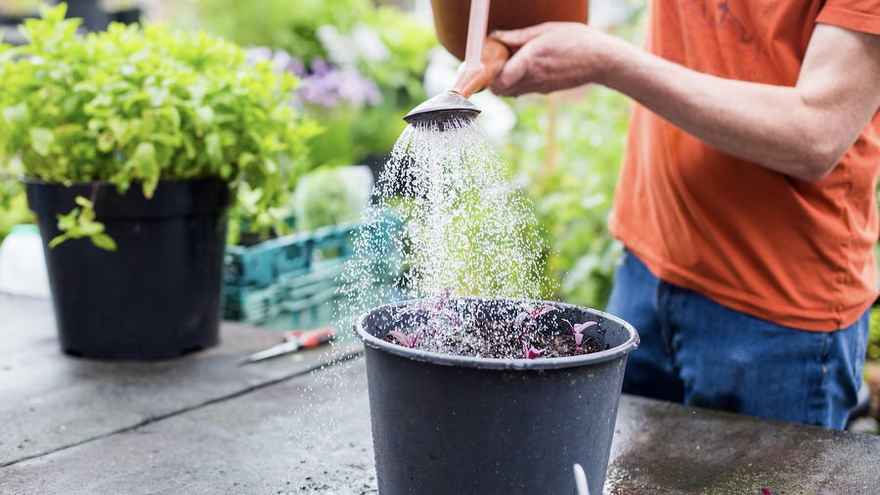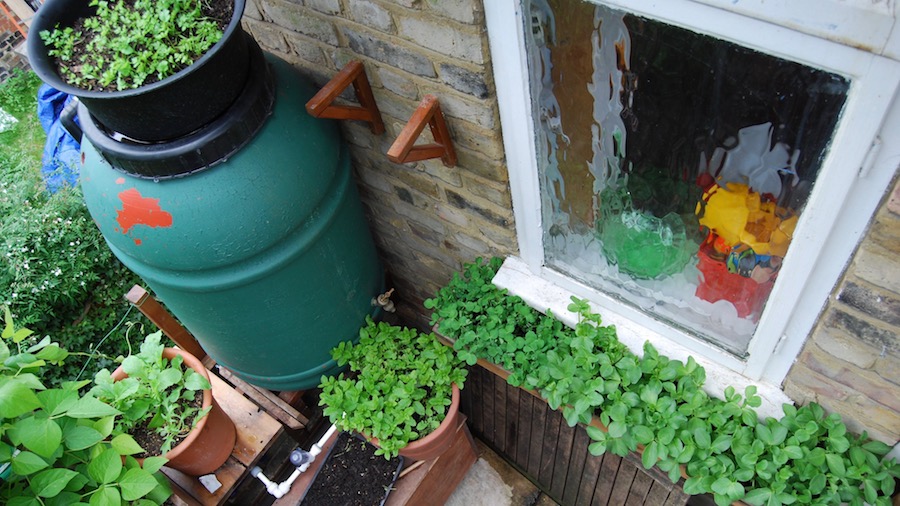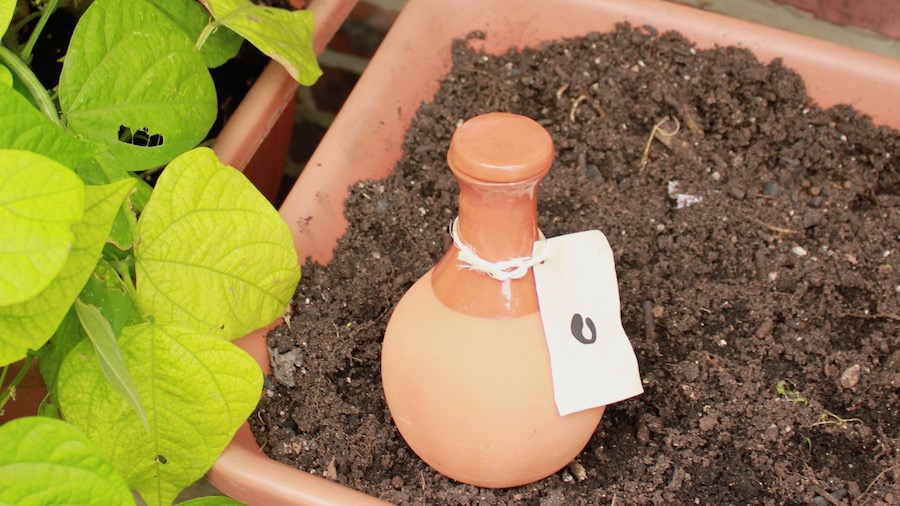Eight tips to make watering easier

Regular watering is critical to growing healthy plants in containers. Luckily it can also be an enjoyable, relaxing way to start or end your day. However, if you have a busy life and lots of pots, it can sometimes be a challenge to find the time. The good news is that you can make watering easier, here are eight ideas.
1. Try to have a water source close to your plants
- Installing a water butt / barrel - the best solution if space permits... free water and rainwater is better for plants. NB if growing on a balcony or rooftop, it is critical to first check your space can hold the weight. A full water butt is extremely heavy.
- Or installing an outside tap.
- Or using a portable hose. You can get nifty, small, compact hose reels that you can run from your kitchen or bathroom tap to your balcony, patio or rooftop. As installing a tap or water butt can be difficult in some places, these can be a great alternative.

This is the water butt (an old olive barrel) that I installed on my London balcony. It is resting on top of an external wall to take its weight - and tied on with metal wire so it can't fall off.
2. Use large pots
The size of the pots you use makes a big difference to how often they need watering. Small pots like yoghurt pots dry out fast - and can need watering two, three or even more times a day on hot or windy days. Bigger pots may only need watering once a day or even every few days (depending on what you are growing and the weather) - and will survive better if you go away for a weekend. The downside of larger pots, of course, is that they take up more space and are heavier (a particular issue for balcony / rooftop growing) - but as a general rule, use the largest pots you can to make watering easier for yourself.
3. Water reservoirs
You can buy or build containers with water reservoirs. As well as making watering easier, these can improve yields (by ensuring plants have a constant water supply). Most standard sized containers with reservoirs still need watering once a day. This is because plants can drink a lot of water - a mature tomato can get through at least a gallon on a hot day! However, the extra water in the reservoir does offer you more leeway, and gives your plants a better chance if you are away for a day or two. There are also a few models with very large reservoirs (like the Quadgrow - NOT an affiliate link), that can hold enough water for a week or more. Very handy if you go away a lot or have no time to water during the week.
4. Ollas and water drippers
Water drippers and ollas work on a similar principle to reservoirs, except that the water is supplied from the top. Ollas are made out of porous terracotta - the water seeps into the soil as it is needed. You can buy beautiful hand made models (like the one pictured below) or make a DIY version by joining terracotta pots together. (Lots of ideas online).

An olla: the unglazed part sits below the soil - water is drawn out as it is needed by the plants.
Bottle water drippers work in a similar way. They can be made out of an old plastic bottle with two small holes drilled in the screwtop lid (or you can buy adjustable drippers that screw onto the plastic bottle). If you cut the base off the bottle you can refill it without removing it from the soil (I've used this technique successfully in hanging baskets which dry out very quickly).

Hanging baskets dry out very quickly. I put water bottle drippers in these baskets to help ensure the tomatoes got a water supply throughout the day.
5. Add a layer of surface material "Mulching"
Adding a layer of pebbles, grit, composted wood chip, chopped up leaves, straw or cardboard will help reduce evaporation from the surface of your containers. Gardeners call this technique "mulching". It is very useful to help reduce the amount of water you need. My favourite mulches are chopped up leaves (which slowly breakdown to release nutrients) and composted wood-chip (available in good gardening stores). But use whatever is easiest to find. You can even mulch with plastic (eg old compost bags), by cutting holes for the plants and tying the plastic onto the container - this method works particularly well on containers with water reservoirs.
6. Add a water retentive material to the potting mix
There are various additives that can improve the water retention of a potting mix, including: vermiculite, perlite, biochar and worm compost. Vermiculite (derived from volcanic rock) holds water particularly well, but unfortunately is also energy intensive to make. Biochar and worm compost are the more sustainable products.

Biochar is finely ground charcoal that can help retain water. Add 5 - 15% to potting mixes.
(You can also buy water retention "granules" or "crystals". I've long been prejudiced against these for no well founded reason. But I've recently read that they are often made from polyacrylamide crystals, a potential health risk. Personally, I'd avoid them).
7. Drip watering systems
If you have a large number of pots or if you are often away from home, you might want to invest in an automatic drip watering system. These attach to a tap (or water butt) and have a battery powered timer that allows you to set how often and how long the plants are watered for. They can be a bit of a fiddle to set up but, for larger container gardens, they can save huge amounts of time. Drip watering systems are not foolproof. Drippers can get blocked, pipes can get leeks and timers can run out of batteries. They can also be tricky to adjust so that each pot gets the right amount of water it needs (particularly if you have lots of different sizes of pot). This means you still need to check your containers for watering, and occasionally water them by hand, too.

Installing an automatic watering system in this, my front yard, has saved loads of time. I still water by hand most days - but it's invaluable on days I don't have fifteen minutes to spare!
8. Gravity watering systems
It is also possible to make your own nifty - and hugely effective - automatic watering system by joining the reservoirs of containers with plumbing, and then connecting these to a water butt. You can read how I made one here. To be fair, I found this system time consuming and tricky to set up (it would be easier if you are a confident plumber), but the end result was incredibly rewarding. A genuinely self watering container garden - with no power needed, just gravity and rainwater!
Your Turn
I'd love to hear about your watering challenges and any ways you have found to make watering easier. And, if you try any of the above ideas, I'd love to hear how you get on.

2 comments
Leave a comment